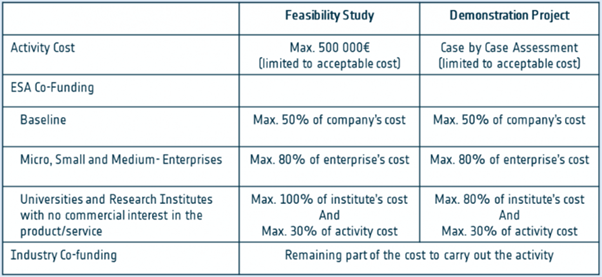FUNDING OPPORTUNITY
This call is part of the umbrella of “Commercial Applications of Space-Enabled Robotics” thematic call for proposals.
This Call for Proposals invites the submission of proposals for feasibility studies and demonstration projects for services that combine the use of satellite technologies and robotics in downstream services for Agriculture applications.
‘Robotics’ is here defined to include physical robots, autonomous drones, machines and vehicles, and precursory solutions or those that enable these (e.g. perception and navigation systems for autonomous vehicle services, connectivity solutions to enable tele-operated robotics).
The following application domains, or others duly identified by industry, may be considered:
- Automated, high-throughput, field phenotyping using sensors, satellite technology, drones and robotics, to support researchers and breeders in selecting desirable crop traits and optimising for crop productivity.
- Use of coordinated fleets of small robots for tasks traditionally undertaken by large tractors, for reduction of excessive soil compaction and greater deployment of precision farming.
- Robotic weed mapping and treatment, leveraging precise positioning, machine vision, and environmentally-friendly treatment mechanisms (mechanical, laser-based, reduced quantity precision-spraying) to identify and remove unwanted plants without causing damage to crops.
- Selective harvesting of crops, including validation of attained crop quality thresholds, and harvesting of target crops without unintentional damage.
- Robotic systems for improved tending of livestock and aquaculture farms to improve animal welfare and environmental sustainability.
- Robotic systems tailored towards atypical farming terrain, such as heterogeneous and hilly topographies.
VALUE OF SPACE
Satellite positioning can provide coarse to high accuracy positioning information to robots, vehicles, machines, and drones operating in outdoor spaces. This can be used for navigation, geo- and timestamping of collected data, time-synchronisation of networked machines, and/or determination of speed and heading. Augmentation of GNSS can offer higher positioning accuracies for certain use-cases via solutions such as Galileo HAS (High Accuracy Service) or GNSS RTK (Real-Time Kinematic) solutions, with the selection dependent on the service requirements.
Satellite communications provide data, video and voice communications and may add value to applications implemented in the following service provision scenarios:
- Environments that have inadequate, unreliable, compromised, or altogether absent mobile cellular connectivity.
- Mobile services that operate across regions with varying cellular connectivity quality (good in certain areas, poor in others) and require continuous coverage and availability.
- Services that have high security, robustness and resilience requirements may benefit from satellite communications for redundancy in compromised or unforeseen circumstances.
Satellite Earth Observation - it is expected that satellite earth observation could support robotic solutions at the service level i.e., providing complementary or enabling datasets to support the activities of the autonomous systems. This could be through situational awareness data to support the navigation of a robot, or use of earth observation data to inform, initiate, or halt deployment of an autonomous system. Satellite earth observation data could refer to air quality measurements, thermal heat signatures, optical, radar, meteorology, or combinations thereof.
Spaceflight Technology - Spin-Outs - applications of robotics developed for use in space (and other astronomical objects) that also have commercial applications on Earth, i.e. Spaceflight Spin-Outs, are also considered eligible. This could relate to tele-robotic solutions and algorithms (perception, planning, control…) developed for autonomy of space robotics that have applications on Earth, or otherwise.
WHAT WE LOOK FOR
We look for promising business ideas addressing topics of relevance or related areas that propose:
- attractive market opportunities, identified customer needs and customer engagement
- commercially-viable service concepts
- technically feasible solutions
- added value of space data or technology
- motivated teams with business, technical, and financial expertise
WHAT WE OFFER
We offer funding and support to companies, both for business case assessment and for the development of new, space-based services. Our offer includes:
- zero-equity funding*
- technical and commercial guidance
- access to our network and partners
- ESA brand credibility
*(50-80% depending on SME Status and Member State Approval)
ESA TENDER INFORMATION
The initiative is open to the submission of proposals for Feasibility Studies and Demonstration Projects:
- Feasibility Studies - which provide the preparatory framework to identify, analyse and define new potentially sustainable services
- Demonstration Projects - dedicated to the implementation and demonstration of pre-operational services
HOW TO APPLY
- Scroll down to the ‘Downloads’ section of this webpage to download the official documents at the opening date. Official documents include an Activity Description (including the scope of the call, procurement approach…), an Annex (including relevant use-cases), and other supporting materials (e.g. webinar slides, if applicable)
- Download the "Activity Pitch Questionnaire” template and submit your pitch as instructed in the Activity Pitch Questionnaire guidelines, through the online form (Select ‘Thematic Call (under 1-10494)’ followed by ‘Commercial Applications of Space-Enabled Robotics’ in the ‘Call’ and ‘Activity’ fields on the first page of the APQ).
- ESA will evaluate your pitch. Teams whose pitches are positively evaluated will be invited to prepare an Outline Proposal and then a Full Proposal. Teams must obtain a Letter of Authorisation from their respective National Delegation before submitting a Full Proposal. Contact details of all National Delegates can be found here: National Delegation(s).
WEBINAR
Date: 10th December 10am GMT
Speakers:
- Kees Lokhorst, Senior Researcher Smart Farming and Robotics at Wageningen Livestock Research
- Grigoris Chatzikostas, Partner at reframe.food
- Sophia Pfliegl and Gerd Waizmann - proTime GmbH
AUTHORISATION OF FUNDING
This opportunity is open to companies that intend to develop space-enabled services and products related, but not restricted, to the topics of relevance outlined above. To be eligible for funding, your team must be based in one of the following countries: Austria, Belgium, Czech Republic, Denmark, Estonia, Finland, France, Germany, Hungary, Ireland, Italy, Lithuania, Luxembourg, Norway, Poland, Portugal, Romania, Slovenia, Sweden, Switzerland and United Kingdom. Teams can involve non-European entities, but their contribution to the activity cannot be funded by ESA. Authorisation of Funding letters from the corresponding National Delegations are required as part of the application.




